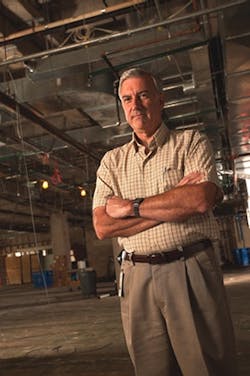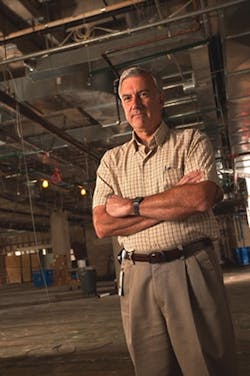Flood of 2008: Alliant Energy
On Thursday, June 12, the facilities team at Alliant Energy in Cedar Rapids, IA, got the call: The power was officially going off. "We asked for 5 minutes," says Karl Schmidt, property manager at Alliant Energy, "and we did everything we could to minimize the impact." Despite the best efforts of the staff - including frantic sandbagging, relocating servers and employees, and fighting to keep the generator up and running - floodwater was rushing into the building at an alarming rate, and it was time to get out.
Losing Power
Alliant Energy Corp., with its corporate headquarters in Madison, WI, provides electricity and natural gas to 1.4 million customers across Iowa, Wisconsin, and Minnesota. Located essentially across the street from the river in downtown Cedar Rapids, IA, the 21-story Alliant Energy Tower is the city's tallest building, at 285 feet. Before the main power services were shut down, IT and Schmidt's team transferred critical operations to generator power, and moved the 15 to 20 people left in the building to the 5th and 6th floors.
The idea, according to Schmidt, was to "ride it out" and wait for the water to go down. "I don't think, at that time, we had any inclination that it was going to get as high as it did," he says. "But, as the day wore on and the water kept coming up, we kept leaving and moving our cars farther from the building. And, finally, the decision was made to evacuate." Steve Gladson, manager of planning, design, and project management, facility services, at Alliant Energy, says, "We were debating how long we could stay; the vice president said, ‘Hang up the phone and go now.' "
Based on estimated crests, the team had predicted that 5 inches of water would creep into the building. When the water inside reached 5 feet (and was climbing) that Thursday afternoon, they exited via boats. Hitting submerged dumpsters and dodging invisible parking meters, the remaining Alliant Energy crew finally realized how dangerous the situation was. "This was not just water that simply came up," says Schmidt, recalling the ride out through the streets-turned-waterways. "It roared through there."
The Damage
After the waters finally receded, Alliant Energy faced a staggering amount of damage to five of its Cedar Rapids facilities - $225 million. "The water really did us in," says Schmidt. At its highest point, the floodwater in the tower reached 7 feet, 6 inches. The entire 1st floor of the building, including rented-out tenant spaces, had to be stripped down to the concrete floors and walls. After the lobby and tenant spaces were emptied of all destroyed materials, flood debris, and muck, they were power washed, disinfected, baked/dehumidified, and tested by an industrial hygienist. "One of our key successes was that we had a disaster recovery team lined up, and we hit it hard," says Terry Shields, manager of facility services, field operations and maintenance, at Alliant Energy.
Despite the heavy losses, the facilities team agrees that it could've been much worse. They were fortunate: The Alliant Energy Tower, unlike most buildings in Cedar Rapids, was built without a basement. "A lot of the other buildings downtown suffered a lot more because the critical operations of their building systems were located in the basement or even on the 1st floor; luckily, we didn't have that here," says Schmidt. Alliant's air-handling equipment is on the 2nd floor, and the telephone system, usually located in a building's basement, was untouched on the 5th floor.
Further damage was mitigated by good advice from Alliant Energy's elevator contractor, who recommended parking the elevators on the 2nd floor. More would've been done to save equipment, says Shields, if they had had any inclination about how high the water would get. "Instead of sandbagging, we could have taken that effort and that time to move furniture, computers, and equipment off of the 1st floor, but we ended up with a lot more water than we ever anticipated," he says.
The Best-Laid Plans
Alliant Energy's crisis-management team has had ample practice in disasters. "The unfortunate (and fortunate) thing is that we've had a lot of practice with crisis management over the last 18 months, with ice storms and, now, flooding," says Ryan Stensland, spokesman at Alliant Energy. "We drill these types of things, but I don't know if we ever had a scenario in which we lost the facility, the headquarters, the dispatch center, and our operating center all in one area. So, there had to be some creative, out-of-the-box thinking," he explains. As the flood took down one facility after another, the team went through three contingency plans before IT operations and employees could be relocated to safe, dry places. The executed plan, says Stensland, "didn't turn out exactly the way it looked on paper," but the team was able to roll with the punches to relocate and immediately focus on getting power back to Alliant Energy customers.
The employees and facilities professionals at Alliant Energy were truly tested during the flood, but they came away with valuable lessons. "I think the secret to a crisis-management plan is that you can't get specific," says Gladson. "You have to keep the plan at a level where you can apply it to whatever happens, even outside of your practiced scenarios."
Gladson advises forming strong relationships with contractors, vendors, and city officials before any disaster occurs. "I think the alliances you make beforehand are the most valuable part because, if you can't pull together the resources you need very quickly ... [when] everyone within 400 blocks is looking for the same resources, the competition for restoration people, electricians, plumbers, etc., it's just phenomenal. So, if you don't have alliances and partnerships built with people ahead of time, you're out there fighting," he says.
Another important key to Alliant Energy's quick and successful recovery was thorough, planned communication. In update meetings, team representatives were included so that no team was left without a clear understanding of directives. An employee hotline was also used to keep relocated employees up to date and dispel any rumors.
Through all the devastation, the facilities team at Alliant Energy can still spot the silver lining. "I always wanted to make improvements to the energy-efficiency aspect of our building," says Schmidt. "When it was built, it had single-pane glass, and the HVAC system is older, so it's an opportunity to replace those." Shields notes the changed attitudes of employees toward the facilities and operations staff after the ordeal: "Through all this, facilities and IT gained a lot of recognition for our efforts," he says.
Schmidt also noticed the gratitude of the building occupants. "We had to spread people all over town and even to other cities, and then move them back," he says. "It was amazing how happy everybody was to be back here."
More Flood Stories:
-
Mercy Medical Center - By Jana J. Madsen
-
Alliant Energy Tower - By Jenna M. Aker
-
The University of Iowa - By Leah B. Garris
-
City of Cedar Rapids - By Jenna M. Aker
-
Guaranty Bank & Trust - By Linda K. Monroe
-
Quaker Oats - By Jana J. Madsen
-
Cedar River Tower - By Linda K. Monroe
Jenna M. Aker ([email protected]) is new products editor at Buildings magazine.

